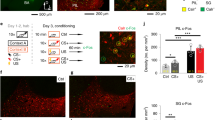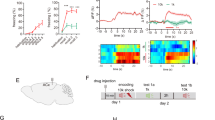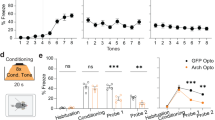Abstract
Long-term synaptic enhancements in cortical and thalamic auditory inputs to the lateral nucleus of the amygdala (LAn) mediate encoding of conditioned fear memory. It is not known, however, whether the convergent auditory conditioned stimulus (CSa) pathways interact with each other to produce changes in their synaptic function. We found that continuous paired stimulation of thalamic and cortical auditory inputs to the LAn with the interstimulus delay approximately mimicking a temporal pattern of their activation in behaving animals during auditory fear conditioning resulted in persistent potentiation of synaptic transmission in the cortico-amygdala pathway in rat brain slices. This form of input timing–dependent plasticity (ITDP) in cortical input depends on inositol 1,4,5-trisphosphate (InsP3)-sensitive Ca2+ release from internal stores and postsynaptic Ca2+ influx through calcium-permeable kainate receptors during its induction. ITDP in the auditory projections to the LAn, determined by characteristics of presynaptic activity patterns, may contribute to the encoding of the complex CSa.
This is a preview of subscription content, access via your institution
Access options
Subscribe to this journal
Receive 12 print issues and online access
$209.00 per year
only $17.42 per issue
Buy this article
- Purchase on Springer Link
- Instant access to full article PDF
Prices may be subject to local taxes which are calculated during checkout








Similar content being viewed by others
References
LeDoux, J.E. Emotion circuits in the brain. Annu. Rev. Neurosci. 23, 155–184 (2000).
Maren, S. & Quirk, G.J. Neuronal signalling of fear memory. Nat. Rev. Neurosci. 5, 844–852 (2004).
Romanski, L.M. & LeDoux, J.E. Equipotentiality of thalamo-amygdala and thalamo-cortico-amygdala circuits in auditory fear conditioning. J. Neurosci. 12, 4501–4509 (1992).
Campeau, S. & Davis, M. Involvement of subcortical and cortical afferents to the lateral nucleus of the amygdala in fear conditioning measured with fear-potentiated startle in rats trained concurrently with auditory and visual conditioned stimuli. J. Neurosci. 15, 2312–2327 (1995).
Armony, J.L., Servan-Schreiber, D., Romanski, L.M., Cohen, J.D. & LeDoux, J.E. Stimulus generalization of fear responses: effects of auditory cortex lesions in a computational model and in rats. Cereb. Cortex 7, 157–165 (1997).
Clugnet, M.C. & LeDoux, J.E. Synaptic plasticity in fear conditioning circuits: induction of LTP in the lateral nucleus of the amygdala by stimulation of the medial geniculate body. J. Neurosci. 10, 2818–2824 (1990).
Bordi, F. & LeDoux, J.E. Response properties of single units in areas of rat auditory thalamus that project to the amygdala. II. Cells receiving convergent auditory and somatosensory inputs and cells antidromically activated by amygdala stimulation. Exp. Brain Res. 98, 275–286 (1994).
Quirk, G.J., Repa, C. & LeDoux, J.E. Fear conditioning enhances short-latency auditory responses of lateral amygdala neurons: parallel recordings in the freely behaving rat. Neuron 15, 1029–1039 (1995).
Quirk, G.J., Armony, J.L. & LeDoux, J.E. Fear conditioning enhances different temporal components of tone-evoked spike trains in auditory cortex and lateral amygdala. Neuron 19, 613–624 (1997).
Rogan, M.T., Staubli, U.V. & LeDoux, J.E. Fear conditioning induces associative long-term potentiation in the amygdala. Nature 390, 604–607 (1997).
McKernan, M.G. & Shinnick-Gallagher, P. Fear conditioning induces a lasting potentiation of synaptic currents in vitro. Nature 390, 607–611 (1997).
Tsvetkov, E., Carlezon, W.A., Benes, F.M., Kandel, E.R. & Bolshakov, V.Y. Fear conditioning occludes LTP-induced presynaptic enhancement of synaptic transmission in the cortical pathway to the lateral amygdala. Neuron 34, 289–300 (2002).
Rumpel, S., LeDoux, J., Zador, A. & Malinow, R. Postsynaptic receptor trafficking underlying a form of associative learning. Science 308, 83–88 (2005).
Shumyatsky, G.P. et al. Stathmin, a gene enriched in the amygdala, controls both learned and innate fear. Cell 123, 697–709 (2005).
Tsvetkov, E., Shin, R.M. & Bolshakov, V.Y. Glutamate uptake determines pathway specificity of long-term potentiation in the neural circuitry of fear conditioning. Neuron 41, 139–151 (2004).
Doyère, V., Schafe, G.E., Sigurdsson, T. & LeDoux, J.E. Long-term potentiation in freely moving rats reveals asymmetries in thalamic and cortical inputs to the lateral amygdala. Eur. J. Neurosci. 17, 2703–2715 (2003).
Dudman, J.T., Tsay, D. & Siegelbaum, S.A. A role for synaptic inputs at distal dendrites: instructive signals for hippocampal long-term plasticity. Neuron 56, 866–879 (2007).
Mahanty, N.K. & Sah, P. Calcium-permeable AMPA receptors mediate long-term potentiation in interneurons in the amygdala. Nature 394, 683–687 (1998).
LeDoux, J.E., Ruggiero, D.A. & Reis, D.J. Projections to the subcortical forebrain from anatomically defined regions of the medial geniculate body in the rat. J. Comp. Neurol. 242, 182–213 (1985).
Mascagni, F., McDonald, A.J. & Coleman, J.R. Corticoamygdaloid and corticocortical projections of the rat temporal cortex: a Phaseolus vulgaris leucoagglutinin study. Neuroscience 57, 697–715 (1993).
Romanski, L.M. & LeDoux, J.E. Information cascade from primary auditory cortex to the amygdala: corticocortical and corticoamygdaloid projections of temporal cortex in the rat. Cereb. Cortex 3, 515–532 (1993).
Shin, R.M., Tsvetkov, E. & Bolshakov, V.Y. Spatiotemporal asymmetry of associative synaptic plasticity in fear conditioning pathways. Neuron 52, 883–896 (2006).
Shin, R.M. et al. Hierarchical order of coexisting pre- and postsynaptic forms of long-term potentiation at synapses in amygdala. Proc. Natl. Acad. Sci. USA 107, 19073–19078 (2010).
Li, X.F., Stutzmann, G.E. & LeDoux, J.E. Convergent but temporally separated inputs to lateral amygdala neurons from the auditory thalamus and auditory cortex use different postsynaptic receptors: in vivo intracellular and extracellular recordings in fear conditioning pathways. Learn. Mem. 3, 229–242 (1996).
Johnson, L.R. et al. A recurrent network in the lateral amygdala: a mechanism for coincidence detection. Front. Neural Circuits 2, 3 (2008).
Sugita, S., Tanaka, E. & North, R.A. Membrane properties and synaptic potentials of three types of neurone in rat lateral amygdala. J. Physiol. (Lond.) 460, 705–718 (1993).
Li, X.F., Armony, J.L. & LeDoux, J.E. GABAA and GABAB receptors differentially regulate synaptic transmission in the auditory thalamo-amygdala pathway: an in vivo microiontophoretic study and a model. Synapse 24, 115–124 (1996).
Lang, E.J. & Paré, D. Similar inhibitory processes dominate the responses of cat lateral amygdaloid projection neurons to their various afferents. J. Neurophysiol. 77, 341–352 (1997).
Bissière, S., Humeau, Y. & Lüthi, A. Dopamine gates LTP induction in lateral amygdala by suppressing feedforward inhibition. Nat. Neurosci. 6, 587–592 (2003).
Kodirov, S.A. et al. Synaptically released zinc gates long-term potentiation in fear conditioning pathways. Proc. Natl. Acad. Sci. USA 103, 15218–15223 (2006).
Tully, K., Li, Y., Tsvetkov, E. & Bolshakov, V.Y. Norepinephrine enables the induction of associative long-term potentiation at thalamo-amygdala synapses. Proc. Natl. Acad. Sci. USA 104, 14146–14150 (2007).
Asztely, F., Erdemli, G. & Kullmann, D.M. Extrasynaptic glutamate spillover in the hippocampus: dependence on temperature and the role of active glutamate uptake. Neuron 18, 281–293 (1997).
Huang, Y.Y. & Kandel, E.R. Postsynaptic induction and PKA-dependent expression of LTP in the lateral amygdala. Neuron 21, 169–178 (1998).
Bauer, E.P., Schafe, G.E. & LeDoux, J.E. NMDA receptors and L-type voltage-gated calcium channels contribute to long-term potentiation and different components of fear memory formation in the lateral amygdala. J. Neurosci. 22, 5239–5249 (2002).
Li, H., Chen, A., Xing, G., Wei, M.L. & Rogawski, M.A. Kainate receptor–mediated heterosynaptic facilitation in the amygdala. Nat. Neurosci. 4, 612–620 (2001).
Bortolotto, Z.A. et al. Kainate receptors are involved in synaptic plasticity. Nature 402, 297–301 (1999).
Raymond, C.R. & Redman, S.J. Different calcium sources are narrowly tuned to the induction of different forms of LTP. J. Neurophysiol. 88, 249–255 (2002).
Bardo, S., Cavazzini, M.G. & Emptage, N. The role of the endoplasmic reticulum Ca2+ store in the plasticity of central neurons. Trends Pharmacol. Sci. 27, 78–84 (2006).
Li, P. et al. Kainate-receptor–mediated sensory synaptic transmission in mammalian spinal cord. Nature 397, 161–164 (1999).
Ko, S., Zhao, M.G., Toyoda, H., Qiu, C.S. & Zhuo, M. Altered behavioral responses to noxious stimuli and fear in glutamate receptor 5 (GluR5)- or GluR6-deficient mice. J. Neurosci. 25, 977–984 (2005).
Burnashev, N., Villarroel, A. & Sakmann, B. Dimensions and ion selectivity of recombinant AMPA and kainate receptor channels and their dependence on Q/R site residues. J. Physiol. (Lond.) 496, 165–173 (1996).
Bowie, D. & Mayer, M.L. Inward rectification of both AMPA and kainate subtype glutamate receptors generated by polyamine-mediated ion channel block. Neuron 15, 453–462 (1995).
Wilding, T.J., Zhou, Y. & Huettner, J.E. Q/R site editing controls kainate receptor inhibition by membrane fatty acids. J. Neurosci. 25, 9470–9478 (2005).
Koike, M., Iino, M. & Ozawa, S. Blocking effect of 1-naphthyl acetyl spermine on Ca2+-permeable AMPA receptors in cultured rat hippocampal neurons. Neurosci. Res. 29, 27–36 (1997).
Humeau, Y., Shaban, H., Bissiere, S. & Lüthi, A. Presynaptic induction of heterosynaptic associative plasticity in the mammalian brain. Nature 426, 841–845 (2003).
Rodrigues, S.M., Bauer, E.P., Farb, C.R., Schafe, G.E. & LeDoux, J.E. The group I metabotropic glutamate receptor mGluR5 is required for fear memory formation and long-term potentiation in the lateral amygdala. J. Neurosci. 22, 5219–5229 (2002).
Humeau, Y. et al. Dendritic spine heterogeneity determines afferent-specific Hebbian plasticity in the amygdala. Neuron 45, 119–131 (2005).
Harvey, C.D. & Svoboda, K. Locally dynamic synaptic learning rules in pyramidal neuron dendrites. Nature 450, 1195–1200 (2007).
Paré, D. & Collins, D.R. Neuronal correlates of fear in the lateral amygdala: multiple extracellular recordings in conscious cats. J. Neurosci. 20, 2701–2710 (2000).
Richardson, R.J., Blundon, J.A., Bayazitov, I.T. & Zakharenko, S.S. Connectivity patterns revealed by mapping of active inputs on dendrites of thalamorecipient neurons in the auditory cortex. J. Neurosci. 29, 6406–6417 (2009).
Acknowledgements
We thank Y. Li and K. Tully for constructive discussions. This study was supported by US National Institutes of Health grants MH083011, MH090464 (V.Y.B.) and MH079079 (S.S.Z.), the National Alliance for Research on Schizophrenia and Depression (V.Y.B.), Whitehall Foundation (V.Y.B.), and US Army Medical Research Acquisition Activity grant #W81XWH-08-2-0126 (V.Y.B.).
Author information
Authors and Affiliations
Contributions
J.-H.C., I.T.B., E.G.M., K.M.M., W.A.C. and S.S.Z. performed the experiments and analyzed the results. V.Y.B. and J.-H.C. designed the experiments, interpreted the results and wrote the paper.
Corresponding author
Ethics declarations
Competing interests
The authors declare no competing financial interests.
Supplementary information
Supplementary Text and Figures
Supplementary Figures 1–15 (PDF 2620 kb)
Rights and permissions
About this article
Cite this article
Cho, JH., Bayazitov, I., Meloni, E. et al. Coactivation of thalamic and cortical pathways induces input timing–dependent plasticity in amygdala. Nat Neurosci 15, 113–122 (2012). https://doi.org/10.1038/nn.2993
Received:
Accepted:
Published:
Issue Date:
DOI: https://doi.org/10.1038/nn.2993
This article is cited by
-
N-acetylcysteine facilitates extinction of cued fear memory in rats via reestablishing basolateral amygdala glutathione homeostasis
Acta Pharmacologica Sinica (2022)
-
Targeting neuronal nitric oxide synthase and the nitrergic system in post-traumatic stress disorder
Psychopharmacology (2022)
-
Downregulation of kainate receptors regulating GABAergic transmission in amygdala after early life stress is associated with anxiety-like behavior in rodents
Translational Psychiatry (2021)
-
Deletion of Dtnbp1 in mice impairs threat memory consolidation and is associated with enhanced inhibitory drive in the amygdala
Translational Psychiatry (2019)
-
Mechanisms of fear learning and extinction: synaptic plasticity–fear memory connection
Psychopharmacology (2019)



